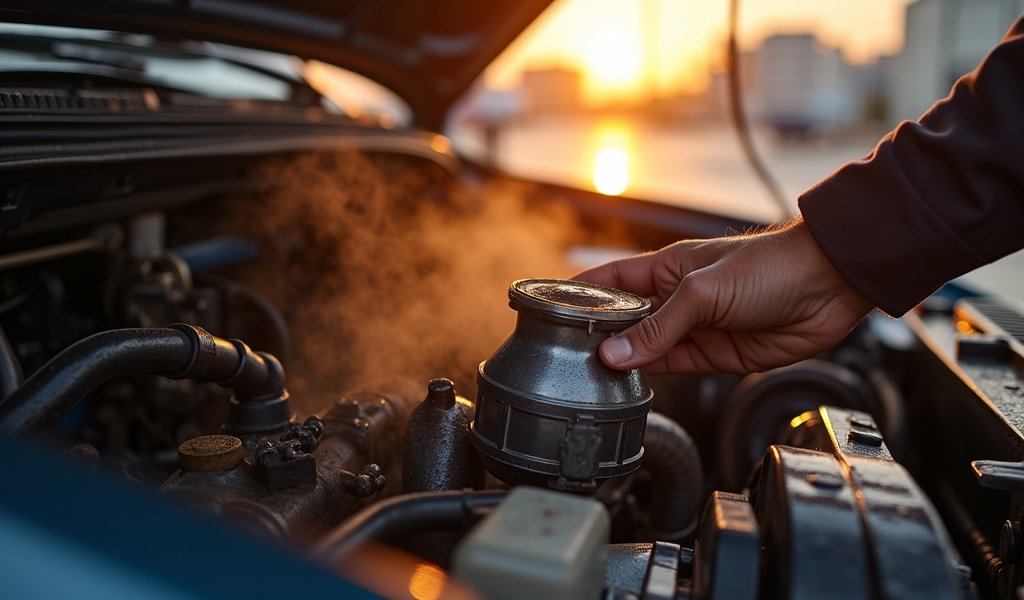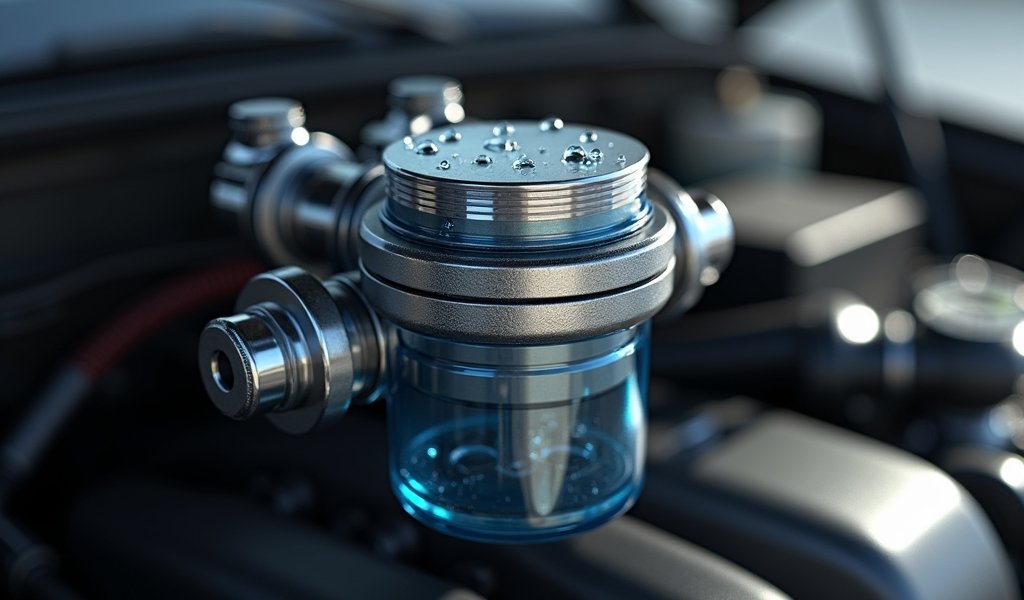Overview
This article explains how diesel fuel filter water separators protect engines by removing water contamination that causes corrosion, bacteria growth, and component damage. It provides detailed information on how these separators work, reviews five recommended models, offers installation and maintenance guidance, and highlights warning signs of separator problems that require immediate attention.
Table of Contents
- Why Water Separators Matter For Your Diesel Engine
- How Diesel Fuel Filter Water Separators Work
- Top 5 Diesel Fuel Filter Water Separators Worth Your Money
- Installation Tips: Getting It Right the First Time
- Maintenance Schedule: Keeping Your Separator Working Efficiently
- Warning Signs Your Water Separator Needs Attention
- Conclusion: Protecting Your Diesel Investment
- Frequently Asked Questions
Why Water Separators Matter For Your Diesel Engine
Water is the arch-nemesis of your diesel engine. I’ve seen it destroy $10,000 engines in a matter of months when left unchecked. As a diesel mechanic for over 15 years, I can’t stress enough how critical a quality diesel fuel filter water separator is for protecting your investment.
Every time you fill up, you’re potentially introducing water into your fuel system. Even the best fuel suppliers can’t completely eliminate moisture, especially in humid climates where condensation is a constant battle. That water, even in small amounts, unleashes a cascade of destructive processes inside your precious engine.
Water causes corrosion in your fuel system components, damages injector pumps, and creates the perfect breeding ground for bacteria and fungi (often called “diesel bug”). In freezing temperatures, water can crystallize and block fuel lines, leaving you stranded at the worst possible moment. Perhaps most alarmingly, water contamination dramatically reduces the lubricating properties of diesel fuel, leading to premature wear on expensive components.
A high-quality diesel fuel filter water separator acts as your engine’s guardian, silently protecting it from these threats day in and day out. It’s not just an accessory—it’s essential preventive maintenance that can save you thousands in repair costs and extend your engine’s life significantly.
How Diesel Fuel Filter Water Separators Work
Diesel fuel filter water separators work through an elegant combination of physics and filtration technology. The process isn’t complicated once you understand the principles, but it’s remarkably effective when properly implemented.
At their core, these devices exploit a simple fact: water is heavier than diesel fuel and the two don’t mix. When contaminated fuel enters the separator, it first passes through a specialized filter element—often made from water-repelling (hydrophobic) materials like silicone-treated cellulose or advanced synthetic media. This element causes water droplets to coalesce (stick together), forming larger droplets that are easier to separate.
As the fuel moves through the system, these water droplets, now heavier and larger, naturally sink to the bottom of the collection bowl where they’re safely stored away from the fuel flow. Meanwhile, the cleaned diesel continues through the outlet port to your engine’s injectors and combustion chamber.
Most quality separators include additional features like:
- Clear collection bowls for visual inspection
- Drain valves for easy water removal
- Water-in-fuel sensors that alert you when it’s time to drain
- Secondary filtration elements to catch dirt and particulates
- Heating elements in some models to prevent gelling in cold weather
The effectiveness of a separator is typically measured by its efficiency (percentage of water removed), micron rating (size of particles trapped), and flow rate capacity (measured in gallons per hour). A quality unit for most pickup trucks and medium-duty applications should remove at least 95% of water while maintaining adequate fuel flow for your engine’s demands.

Top 5 Diesel Fuel Filter Water Separators Worth Your Money
1. CAT 1R-0750 Fuel Water Separator
The CAT 1R-0750 is a beast of a separator that’s earned my trust on heavy equipment and high-performance diesel trucks alike. With a 2-micron rating, it captures virtually everything you don’t want reaching your injectors. The filtration efficiency is staggering—removing 99% of water while handling flow rates up to 75 GPH.
What sets the CAT apart is its rock-solid construction. The metal housing laughs in the face of vibration and extreme temperatures, while the clear collection bowl lets you instantly check water levels with a glance. I’ve installed dozens of these on commercial fleets, and they just keep performing year after year with minimal maintenance.
The only downside is the price tag ($80-120), but considering what you’re protecting, it’s an investment that pays for itself many times over. Compatible with numerous Caterpillar engines and adaptable to other makes, it’s the gold standard for serious diesel protection.
2. RACOR 500FG Turbine Series
If you’re running marine diesel applications or simply want the best of the best, the RACOR 500FG deserves your attention. This legendary separator has protected boat engines from contaminated fuel for decades, and its reputation among marine mechanics is untouchable.
The Aquabloc® filter media repels water while capturing particulates down to 30 microns (with 2 and 10-micron options available). The clear bowl design provides immediate visual confirmation that your system is working properly—there’s something deeply satisfying about seeing those water droplets safely contained below your clean fuel.
With a hefty 60 GPH flow rate, die-cast aluminum construction, and tool-free bowl removal for servicing, the RACOR balances premium performance with user-friendly design. Yes, the $200-300 price point is significant, but when you’re protecting a marine diesel engine far from shore, this level of reliability delivers priceless peace of mind.
3. Baldwin BF7633
The Baldwin BF7633 hits the sweet spot of performance, reliability, and value that makes it perfect for medium-duty trucks and agricultural equipment. With a 7-micron rating, it strikes an excellent balance between flow capacity (45 GPH) and filtration efficiency.
What I love about the Baldwin is its straightforward design combined with thoughtful features like an integrated water sensor probe option and an easy-to-use drain valve. The aluminum housing stands up to harsh environments while providing excellent heat dissipation. At $45-80, it delivers professional-grade protection without breaking the bank.
I’ve recommended this model to countless farmers and contractors who need reliable protection for equipment that can’t fail during critical seasonal operations. The widely available replacement filters also mean you’ll never be stuck waiting days for proprietary parts during busy seasons.
4. FASS Titanium Series
For the performance enthusiast who demands the ultimate in fuel system protection and enhancement, the FASS Titanium Series represents the pinnacle of diesel filtration technology. More than just a water separator, this comprehensive system combines 3-micron filtration with advanced air separation technology and an integrated lift pump.
The performance benefits are remarkable—many users report increased fuel economy, smoother idle, reduced emissions, and noticeable power gains. With flow rates from 95-290 GPH (depending on the model), these systems can support highly modified engines while providing superior contamination protection.
The fuel pump component maintains consistent pressure regardless of tank level, eliminating the strain on factory systems. At $600-1,200, it’s a serious investment, but the performance gains combined with the lifetime warranty on select components make it worthwhile for enthusiasts and heavy users who demand the absolute best.
5. WIX 33358 Complete In-Line Fuel/Water Separator
Sometimes simple, affordable solutions are exactly what you need. The WIX 33358 delivers reliable water separation in a compact, budget-friendly package perfect for light-duty trucks and passenger vehicles with diesel engines.
With a 10-micron rating and flow capacity up to 35 GPH, it provides ample protection for stock applications without the complexity of more advanced systems. The clear bowl makes visual inspection a breeze, and the universal fittings simplify installation for DIY enthusiasts.
At $30-50, it’s an accessible entry point for diesel owners just beginning to take fuel system protection seriously. I often recommend this to drivers of passenger diesels who want basic protection without committing to more elaborate setups. The straightforward design also makes maintenance remarkably simple—important for encouraging regular servicing.
Installation Tips: Getting It Right the First Time
Installing your diesel fuel filter water separator correctly is crucial for optimal performance and reliability. I’ve seen plenty of quality units fail simply because they weren’t installed with care, so let me share some professional guidance to save you headaches down the road.
First, location matters enormously. The ideal placement is between your fuel tank and the engine’s primary fuel filter, mounted in a protected area away from excessive heat sources or moving parts. Always install the separator vertically when possible—horizontal mounting significantly reduces separation efficiency since water needs gravity’s help to settle properly.
Pay careful attention to flow direction. Most separators have clearly marked inlet and outlet ports or arrows indicating proper flow orientation. Installing backward is a common mistake that renders the unit nearly useless and can lead to fuel starvation issues.
Use appropriate fuel-rated hose and quality clamps for all connections. Regular rubber hose will deteriorate quickly when exposed to diesel fuel, creating dangerous leak points. Double-check all connections with a flashlight after installation, looking for any signs of seepage or loose fittings.
Remember to leave adequate service clearance beneath the unit for draining water and replacing filters. I recommend at least 3-4 inches of open space below the drain valve for comfortable access with a container to catch the drained water.
After installation, prime the system carefully following the manufacturer’s instructions. Diesel fuel systems hate air, and a poorly primed separator will cause hard starting and potential damage to injection pumps. Most systems require either a priming pump or careful filling of the filter housing before final installation.
For complex systems like the FASS Titanium Series, consider professional installation if you’re not completely confident in your mechanical abilities. The money spent on proper installation is far less than the cost of repairing a fuel system damaged by incorrect setup.

Maintenance Schedule: Keeping Your Separator Working Efficiently
Maintaining your diesel fuel filter water separator isn’t complicated, but it requires consistency. Think of it as a small, regular investment that pays enormous dividends in engine protection and performance.
For typical diesel pickups and medium-duty applications, I recommend checking the water collection bowl weekly. This quick visual inspection takes seconds but tells you volumes about both your separator’s functioning and your fuel quality. If you notice rapid water accumulation, you might want to investigate your fuel source or check for tank condensation issues.
Drain collected water whenever it reaches the level indicated by the manufacturer—typically when the bowl is about 1/3 full. Never let water sit in the collection bowl until it’s completely full, as it could be forced through the system during periods of high demand. In humid environments or winter months when condensation increases, you might need to drain water bi-weekly or even daily for heavily used equipment.
Replace filter elements according to your manufacturer’s recommendations, which typically falls between 10,000-15,000 miles for passenger vehicles or every 300-500 hours for equipment. However, don’t rely solely on mileage or hours—consider your fuel filter replacement schedule in the context of your operating conditions. Dusty environments, questionable fuel sources, or frequent idling might necessitate more frequent changes.
Keep a maintenance log with dates of water draining and filter replacements. This simple practice helps identify patterns and ensures you never lose track of when service is due. I recommend storing a spare filter element with your vehicle tools—it’s inexpensive insurance against finding yourself stranded when a replacement is needed.
For separators with water-in-fuel sensors, test the sensor annually by deliberately filling the collection bowl with water until the warning activates. This confirms your alert system is functioning correctly and could prevent a nasty surprise down the road.
Remember that seasonal transitions often demand special attention. Fall and spring temperature swings create ideal conditions for condensation in fuel tanks, potentially overwhelming a neglected separator. A thorough inspection and service during these transitional periods is time well spent.
Warning Signs Your Water Separator Needs Attention
Your diesel engine has a way of communicating when your water separator needs attention, but you need to know how to interpret the signals. Catching these warning signs early can prevent expensive repairs and keep you rolling without interruption.
The most obvious indicator is water visible in the collection bowl. If you can see the water level approaching or exceeding the manufacturer’s maximum line, it’s time to drain immediately. Don’t put this off—water that rises above the separation chamber can be pulled into your engine during periods of high fuel demand.
Hard starting, especially in cold weather, often points to water contamination issues. When water freezes in fuel lines or components, it creates blockages that prevent proper fuel delivery. If your diesel suddenly becomes reluctant to start on cold mornings, checking your water separator should be your first diagnostic step.
A sudden decrease in fuel economy can indicate your fuel injectors need cleaning due to water contamination slipping past a failing separator. Water-contaminated fuel burns less efficiently, forcing your engine to consume more fuel for the same power output. If your typical mileage drops by 5% or more without explanation, inspect your fuel system components.
Rough running or uneven idle often signals water has reached the combustion chamber. Water doesn’t compress like diesel fuel, potentially causing erratic performance, misfiring, or strange knocking sounds. This symptom demands immediate attention as it indicates water has already bypassed your separator’s protection.
Excessive black or white smoke from the exhaust provides another visual clue. White smoke often indicates water in the combustion chamber, while black smoke can suggest injector problems caused by water contamination. Either symptom warrants prompt investigation of your filtration system.
Finally, pay attention to warning lights. Modern diesel engines monitor fuel system performance, and many water separators include sensors that trigger dashboard warnings when water reaches critical levels. Never ignore these alerts—they’re designed to protect your engine from potentially catastrophic damage.
If you notice any of these warning signs, inspect your fuel water separator immediately and address any issues before continuing operation. The small inconvenience of maintenance is nothing compared to the cost and downtime of major repairs.
Conclusion: Protecting Your Diesel Investment
Your diesel engine represents a significant investment—whether it powers your daily driver pickup, your worksite equipment, or your weekend boat. A quality diesel fuel filter water separator stands as your first line of defense against one of the most insidious threats to that investment: water contamination.
Throughout this guide, we’ve explored how these seemingly simple devices use sophisticated engineering to protect complex engine systems. From the premium protection of the RACOR 500FG to the budget-friendly reliability of the WIX 33358, there’s a solution for every application and budget. The key is choosing a separator that matches your specific needs and maintaining it diligently.
I’ve witnessed firsthand the devastating effects of water-contaminated diesel fuel—scored cylinders, ruined injectors, corroded pumps, and engines rendered completely inoperable. Almost invariably, these expensive failures could have been prevented with a modest investment in quality filtration and regular maintenance.
Remember that water contamination doesn’t announce itself with dramatic symptoms until significant damage has already occurred. By then, you’re looking at repair bills that dwarf the cost of prevention. This is one area of vehicle maintenance where proactivity truly pays dividends.
Whether you choose one of our recommended separators or another quality option, the important thing is that you’re taking steps to protect your diesel engine from its invisible enemy. Your future self—and your wallet—will thank you for your foresight.
Have you experienced water contamination issues with your diesel engine? Which separator has worked best for your application? Share your experiences in the comments below—your insights might help another diesel owner avoid costly problems!
Frequently Asked Questions
How often should I drain water from my diesel fuel filter water separator?
Drain water whenever it reaches about 1/3 of the collection bowl capacity, typically every 1-2 weeks. Increase frequency during humid conditions or if you notice rapid water accumulation.
Can I install a diesel fuel filter water separator myself?
Yes, most basic separators can be installed as a DIY project if you have moderate mechanical skills. Complex systems like the FASS Titanium might warrant professional installation for optimal performance.
Will a water separator improve my fuel economy?
Yes, by ensuring only clean, water-free fuel reaches your injectors, a separator helps maintain optimal combustion efficiency. Many users report 2-5% improvement in fuel economy after installation.
What happens if I ignore water in my diesel fuel?
Water causes corrosion, promotes microbial growth, reduces lubrication, and can freeze in cold weather. Ignoring it leads to poor performance, reduced reliability, and eventually catastrophic engine damage requiring expensive repairs.
Do I need a water separator if my truck already has a factory fuel filter?
Yes, most factory filters provide basic water separation but lack the efficiency and capacity of dedicated separators. An aftermarket unit provides superior protection, especially for vehicles regularly exposed to varying fuel quality or humid conditions.
AI-generated content for educational purposes only. Consult a certified diesel technician before making modifications to your vehicle’s fuel system.


Pingback: Biodiesel Blend Ratio Limitations:5 Tips - knowsyourcar.com